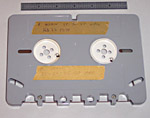Click on the image to open a larger view in a new window.
Note: Audio tape is generally A wind (oxide facing the hub of the reel). The tape is recorded/played so earlier material is at the right (i.e., tape moves left to right). This view is THROUGH the tape looking at the heads, with the magnetic coating facing away from the viewer.
See also: equalization, noise reduction, reels & hubs, speeds, synchronization, tape timing, tape winding, and track configurations.
After evaluating the options for reproducing 1/4″ cartridge and cassette tapes in their dedicated machines, we have elected to remove the tape from the cartridges and transfer the tapes on reel-to-reel machines. 
In the 1960s, RCA introduced a two-hub cartridge that looks like a cassette on steroids. See the photo on the right and click on it to open a larger copy in a new window. This uses standard quarter-track 1/4″ tape.
The National Association of Broadcasters standardized in the 1970s the professional cartridge tape system that had been used since the 1950s. It was originally mono utilizing the NAB two-track standard. One channel held the program and the other held cue tones. When a stereo cartridge was needed, the same track width as quarter-track tape was used, but heads with three evenly spaced channels were made. The channels were left, right, and cue tones. In the 1980s, Pacific Recorders and Engineering (later to become Pacific Research and Engineering and then absorbed by Harris Corporation), built their higher-quality TOMCAT system with MaxTrax heads. These heads had three channels like the NAB system, but cue was very narrow and relegated to the bottom edge. The audio tracks were closer together than the NAB two-track standard, but were of the same width. In all of these machines, the pinch roller was part of the machine, not the cartridge.
In 1956, “Madman” Muntz developed a 4-track cartridge system for automobile sound that used a cartridge similar to the NAB cartridge with the pinch roller as part of the tape machine. This didn’t take off (and when it did, it didn’t gain much traction).
In 1965, Ampex, LearJet, and Ford got together to market the 8-track cartridge for automotive use. There is an extensive site dedicated to 8-tracks. Our Sony APR-5003 with 8-track heads gets excellent sound out of old 8-tracks. There were even quadraphonic 8-tracks, and we can transfer them as well. The big difference between the 4-track and 8-track cartridges is that the 8-tracks have the pinch (pressure) roller in the cartridge, while with the NAB broadcast and the 4-track cartridges the pinch roller is part of the machine and there is a large hole for it to come up into the cartridge. For those of you who want an 8-track repaired to play in an 8-track player, John Mersereau at Unamic Sound in Vestal, NY, is set up to do that work. 607 748 8995. As of October 2013, we have become pessimistic after transferring a number of 8-track cartridges. While we have found a few quality commercial releases, the home recordings are generally quite poor, especially since there were few quality 8-track recorders manufactured, it was mostly a commercially manufactured product. Please read my musings after several disappointing 8-track transfers . Please carefully think about whether you really want to do this after reading.
In the mid-1970s, Sony introduced the Elcaset which used a dedicated 1/4″ cassette with essentially the 4-channel configuration, although there was provision for (I believe never implemented) two data tracks in the middle, and the machine recorded pair-wise stereo tracks, rather than interleaved like all the other formats. Only a few thousand of these machines were made, and the last 2,000 were sold off in Finland at fire-sale prices between 1979-1981.
Broadcast, 4-track, and 8-track cartridges are endless-loop devices while RCA cartridges and Elcasets, like Philips cassettes, are two-hub devices that can be thought of as a small reel-to-reel system in a single package. Only the two-hub devices have a rewind or reverse mode. The endless-loop cartridges only go forward. Viewed from the rear of the cartridge as you place them into the machine, the tape moves left to right, with oxide out at the front. The tape pulls out of the centre of the pack and winds onto the outside.
I am probably the only one insane enough to gear up for transferring these old tapes, but I’ve had enough satisfied clients to have made it worth my while.
